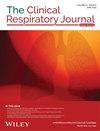This study was conducted to further understand the clinical characteristics of COVID-19 associated pulmonary aspergillosis (CAPA).
In this study, we conducted a multicenter retrospective survey, which included patients with COVID-19 from five hospitals in Zhejiang, China. A total of 197 patients with COVID-19 were included in the study. The detailed clinical data of seven patients with CAPA from COVID-19 onset to 28 days after CAPA were collected and analyzed.
In the total of 197 patients, 36 were admitted to the intensive care unit (ICU), 13 received mechanical ventilation; among them, nine received extracorporeal membrane oxygenation (ECMO). All seven cases acquired CAPA in the ICU, six cases during MV, of which five cases received ECMO treatment at the same time, and one case had been off ventilation. The average duration from onset of COVID-19 to CAPA was 25.4 days, from ICU admission to CAPA was 23.4 days, and from MV to CAPA was 22.1 days. All seven patients were diagnosed with CAPA without neutropenia, four with lymphopenia, seven with decreased CD4+ T lymphocyte, and five with decreased CD8+ T lymphocyte. All cases received glucocorticoids before CAPA, with an average duration of 15 days and an average cumulative dose of 762.5 mg prednisolone. In addition, all patients suffered bacterial infections and received antibacterial agents before CAPA, with an average duration of 22.6 days. CAPA was diagnosed according to a positive culture of Aspergillus fumigatus in sputum or bronchoalveolar lavage fluid (BALF) and positive serum 1,3-β-d-glucan in all seven patients; serum galactomannan was positive in three cases. Rhizopus was cultured from BALF of one case during treatment of CAPA. All patients received antifungal therapy, and the 28-day survival rate was 100%.
The incidence of CAPA in patients with COVID-19 admitted to the ICU was 19.44%, all patients with CAPA had a history of chronic underlying diseases, and all had a history of high dose glucocorticoid. Patients with CAPA had no specific clinical symptoms and lung imaging manifestations, and diagnosis depended on Aspergillus culture and galactomannan detection. For patients with COVID-19 with these high-risk factors, Aspergillus culture and GM testing should be performed actively to avoid delaying the diagnosis of CAPA.



